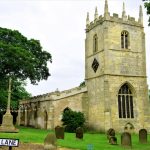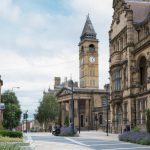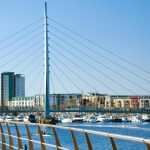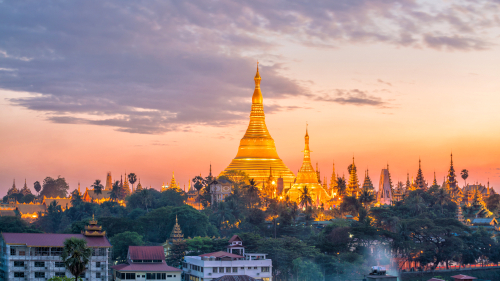
A quick guide to Yangon
Yangon is by far Myanmar’s largest and commercially important city, with the population of its greater metropolitan area (circa is estimated to be somewhere between 6 and 7 million. Up to 2006, Yangon served as the country’s capital city, when the status and nation’s administrative functions were transferred to purpose-built city of Naypyidaw in central Myanmar.
Yangon is situated in south-central Myanmar at the head of the estuary of the Yangon River, about 20 miles (33 km) upstream of the Gulf of Martaban, part of the Bay of Bengal. In the mid-19th century, the city quickly gained stature and prosperity as an important regional capital of the British Empire, as well as being renamed as Rangoon. As a result of its colonisation and the country’s relative lack of recent development, unlike much of Southeast Asia, many of its colonial buildings, for now at least, have survived. The city is home to the fabulous Shwedagon Pagoda, making it a somewhat of a ‘Mecca’ for Buddhists.
A Fleeting History
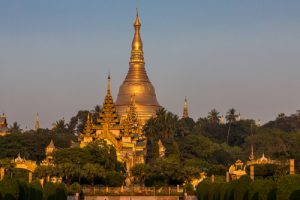
The resplendent Schwedagon Pagoda in Dagon
Archaeologists think that the first permanent structure in Yangon was a stupa erected by the then-dominant Mon people at the site of the current Shwedagon Pagoda, sometime between the 6th
and 10th century. The settlement of Dagon gradually began to develop around the religious monument. Over the centuries, given Yangon’s propensity towards earthquakes, the stupa was rebuilt many times, on each occasion the resultant monument being more resplendent than the last. However, even by the mid-18th century, Dagon was little more than a fishing village.
In 1755, King Alaungpaya, founder of the Konbaung Dynasty, conquered central Myanmar and built a harbour at the confluence of the Yangon and Bago rivers. This proved a catalyst for the development of Dagon, which was subsequently renamed Yangon, ironically translating as ‘end of strife’. In the 1790s, the British owned East India Company established an operation in the city. By 1823, the estimated population of Yangon was around 30,000.
In 1826, the British captured Yangon after the First Anglo-Burmese War but returned it to Burmese administration after the war. In 1841, much of the city was destroyed by fire but quickly rebuilt. However, in 1852, the city again suffered extensive damage, this time during the Second Anglo-Burmese War. The victorious British renamed the city, giving it the more anglicised name of ‘Rangoon’.
It didn’t take long for Rangoon to prosper, mostly on the back of the lucrative teak and gemstone trade, which was fully exploited by the British. Grand and imposing administrative building were built in broad avenues close to, and along, the waterfront of the Yangon River, reflecting the city’s growing wealth. In 1885, Yangon was declared the capital of all British-ruled Burma, after Upper Burma was captured by the British, in the Third Anglo-Burmese War. By the 1890s, Yangon’s rapidly increasing population saw exclusive residential suburbs being built, the most coveted being around Royal (Kandawgyi) Lake and Victoria (Inya) Lake. The founding of hospitals, including Rangoon General Hospital, and centres of learning like Rangoon University, followed in the early 20th century. It was said by this time, that Yangon’s public services and infrastructure were on a par with those of London. By now, Yangon had also become a key stopover for steamships carrying well-heeled travellers. Notable passengers who visited the city in the era included the likes of Rudyard Kipling, W Somerset Maugham, Aldous Huxley and HG Wells.
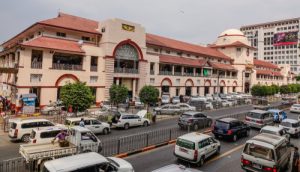
Bogyoke Aung San Market (Scott’s Market) on Sule Boulevard was built in 1926. Photo credit to Pheung D. Nguyen/Shutterstock.com
After World War I, Rangoon became the centre of the Burmese independence movement, often with a contingent of University students leading the way. Three major national strikes against British rule occurring in 1920, 1936 and 1938, were all instigated in Yangon. By the late 1930s, it’s estimated that around 55% of Yangon’s population of 500,000 were of South Asian descent, 33% being native Bamar (Burman), with Chinese, Anglo-Burmese, and other ethnic minorities, making up the rest. However, in 1939, Nationalist ambitions for self-rule suffered a setback with the outbreak of World War II. This led to the subsequent occupation of the country by the Japanese. The Japanese forces were in the end, defeated by the alliance of the Nationalists, led by Ang San, who eventually sided with the Allies to defeat the common enemy.
In 1948, independence of the country was finally realised, with Rangoon continuing as the nation’s capital. However, the economic after-effects of the war, coupled with the many politically motivated old scores to settle in an ethnically divided nation, threw the country into turmoil. It was during this period that many ethnic minorities who had other options decided that life may be better outside Burma. The country’s tumultuous situation paved the way for the relatively bloodless military coup of 1962, led by General Ne Win. However, Ne Win’s leadership and the many years of the country’s self-isolation that followed were to spell near financial disaster for both Yangon and the rest of the country. Although Ne Win officially stood down as president in 1981, he retained a strong influence on the military government until his death in 2002.
The Modern Era
In 1989, the military junta decreed that the country’s anglicised name of Burma and that of the capital, Rangoon, would be changed to designations of the Bamar language. Burma was to become Myanmar and Rangoon’s name was to be changed back to its former title of Yangon. With change coming to the county, Aung San Suu Kyi, daughter of the fabled Aung San, chose to return to the country from the UK, where she had been living as a wife and mother.
The 1990s saw inward investment into the country for the first time for many years, despite there still being a quasi-embargo on Myanmar by many western countries. The outlay came from the likes of China, Japan and Korea, who all proved more than willing to do business through joint ventures with the government. Yangon was to be the main recipient for much of this investment.
In 2006, Yangon lost its capital status to the newly constructed, purpose-built city of Naypyidaw, situated some 240 miles to the North. In 2007, the city was the centre of a nationwide protest against government fuel price hikes, led by a delegation of monks. The dissent, dubbed the ‘Saffron Revolution’, soon escalated to anti-government demonstrations, which culminated in the death of many of the protestants. In 2008, Yangon and the South were struck by Cyclone Nargis, which proved to be the worst natural disaster to hit the country in living memory with the storm damage being estimated at almost one billion USD.
In 2010, the military government looking to engage with the world at large, allowed national elections, began to wind down press censorship and released hundreds of political prisoners, including Aung San Suu Kyi. In 2012, with Aung San Suu Kyi’s NLD Party taking up representation in parliament for the first time, some of the sanctions on Myanmar by the West were lifted. With some of the country’s travel restrictions and surveillance of foreigners by the government lifted, tourist numbers to Myanmar began to increase rapidly.
Climate
Yangon has a typical tropical monsoon climate i.e. that of a wet season and a dry season, with a relatively high level of humidity. The lengthy wet season stretches from May to October, where a substantial amount of rainfall occurs. The dry season lasts from November through to April, where very little rainfall is realised. Annual Average Daily Temperatures show relatively little variance, with average highs ranging from 29 to 36 °C (84 to 97 °F), and average lows ranging from 18 to 25 °C (64 to 77 °F). The hottest time of year is towards the end of the dry season, i.e. March to May when temperature highs can top 40 °C. The wettest months are June to August which coincides with the most humid time of year. November to February sees the lowest daily temperatures coupled with the lowest levels of relative humidity, making it the ideal time to visit Yangon, as well as the rest of the country.
Getting there!
Yangon is the country’s main hub for all forms of travel, with its international airport being the busiest in the country, by far. Domestic flights are relatively cheap and given the poor state of many of Myanmar roads and the size of the country, flying is by far the best option to get around the country.
By air
Yangon International Airport is located 12 miles (19 km) from the city centre (Dagon), which is the country’s main gateway for both international and domestic air travel. Direct flights operate from a number of Asian destinations, including Tokyo, Shanghai, Seoul, Singapore, Hong Kong, Kuala Lumpur, Kolkata, and Dubai. However, Bangkok has the most daily flights to Yangon and consequently, the most popular destination from tourists chose to arrive.
By land
You can enter Myanmar from four border crossing points in Thailand and two in India, but foreigners can currently not cross in Myanmar from either China nor Laos. You can enter Myanmar at Mai Sai, Mai Sot, Phunaron and Ranong from Thailand. However, you will need to get an e-visa beforehand and if travelling by car, you will need to obtain special permission beforehand. The travel situation in Myanmar for foreigners is dynamic, so you should always check the details when planning your journey. Travelling overland by bus to Yangon from any of the border crossings is probably still only for the hardy traveller.
Getting Around!
By air
Although there are around 40 regional airports in Myanmar many domestic services between airports are either infrequent or non-existent. The most frequent services all operate out of Yangon to airports, that are in most cases, close to the country’s most popular tourist destinations i.e. Mandalay, Naung U (for Bagan), Heho (for Inle Lake) and Thandwe (for Ngapali Beach), and to the capital Naypyidaw.
By train
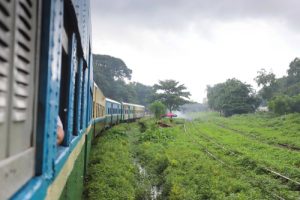
Train travel is a Myanmar is an interesting experience
Yangon Central Railway Station is the main terminus for Myanmar’s entire railway network. At over 5,400 km (3,375 miles) the rail system stretches north to Myitkyina in Kachin State, northeast to Taunggyi and Lashio in the Shan hills, and southwards to Mawlamyine and Dawei on the coast.
Yangon Circular Railway operates a 45 km (28 miles) 39-station commuter rail network that connects Yangon’s 33 townships. The antiquated railway line is mostly used by locals but is currently being upgraded. It takes about 3 hours to complete the entire journey, but you can hop on and off wherever you like and with the fare at around Kyat 300 (US 0.3), it’s hardly likely to break the bank.
By bus
Yangon Bus Service (YBS) is a bus transport network operated by the Region Transport Authority that operates around Yangon. There are also a good number of private operators. Tourists wouldn’t normally take a bus around Yangon as they are normally old and overcrowded, and it’s difficult to fathom exactly where they are going. You may also be a target for thieves, so probably best to stay clear of buses for travel around the city.
Buses out of Yangon depart from Dagon Ayeyar Highway Bus Terminal for the Irrawaddy delta region and Aung Mingala Highway Bus Terminal for other parts of the country. They provide reasonable comfort but journey are often long and can be arduous given the condition of most of the road network.
By taxi
Taxis are cheap in Yangon, but few are metered, so you should always negotiate a price beforehand. It’s around US$10 for the 12-mile journey from the airport to the downtown area. Uber and Grab who also operate in Yangon, who might be a little cheaper. You can take short trips for US$1 – 2, while even journeys across the city rarely cost more than US$5.
Eating Out
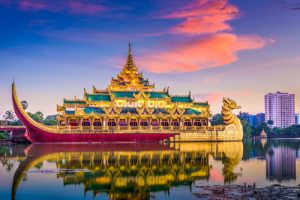
Karaweik Palace is a restaurant on Lake Kandawgyi
Yangon is, without doubt, Myanmar’s most (some, may say ‘only’) cosmopolitan city, which is reflected in the great variety of cuisine that is available. As well as the various domestic regional cooking styles that can be found in eateries throughout the city, Thai, Japanese, Korean, French, Italian and Indian restaurants are all prevalent and popular. If you’re just looking for a light meal or snack, there’s also plenty of teashops, coffee shops, noodle shops and street stalls, where you’ll be able to find cheap refreshments from mid-morning to mid/late evening.
In the downtown area, especially around Sule Pagoda, you’ll also be able to find a number of shops selling rudimentary Indian food at rock bottom prices. Don’t expect the food to be anything like that from your local curry house back home as it’s authentic South Indian style cuisine that’s typically eaten by the masses. At the other end of the scale, luxury hotels provide fine-dining at often well-over-the-top prices, but they still seem to be popular with affluent tourists and well-heeled locals. A number of quite plush bar-restaurants have sprung up across the city since 2010, with some doubling-up as favoured watering holes of ex-pats and middle-class Yangonites, as well as catering for tourists. The Union Bar on Strand Road, near the docklands area, serving top-end pub grub, is a prime example.
Tipping has now become the norm in mid to high-end eateries but isn’t really expected, although no less appreciated, in local cafes and teashops. Many mid to high-end places will automatically add a 10% service charge to the bill where it’s not already indicated as being included in the price.
Don’t miss the Yangon Bakehouse! Located at the Pearl Condo in Bahan township, it’s one of several similar charitable organisations in the city that provides work and training for disadvantaged youths. It offers an array of great takeaway sandwiches, bakes and coffee. The baked in-house bread, which you can also buy – is fantastic! There’s also a small seated area inside the shop if you want to eat in. With a loyal local clientele, expect to queue, if you arrive anytime around lunchtime.
Nightlife
For a large city, it’s probably fair to say Yangon’s nightlife is in the main, fairly low-key. Having said that, it’s far livelier than anywhere else in the rest of the country. Top-end hotels provide live music and other entertainment for their patrons most nights of the week, with some also operate nightclubs. There are also a few independent nightclubs spread across the city which can range from being almost empty to packed full, depending on when you go. However, the one thing all nightclubs have in common is the type and loudness of the music. They all tend to play ‘techno’ music, which is usually belted out at unbelievable loudness. And, while its hard to believe anyone over 25 could appreciate such a cacophony, the locals seem to love (tolerate?) it, regardless of age. In most clubs, especially at weekends, you’ll find there are a number of local girls on the lookout for single males, who will be quite happy to chat (usually in very limited English), especially should you feel the urge to buy them a drink.
There are a few British style pubs in the city, most famously at 50th Street in the downtown area, where you’ll also be able to find pub grub. However, if you’re looking for a uniquely Burmese night out, you could always give one of the ubiquitous, local drinking establishments a try. Dubbed ‘beer stations’, you’ll find them full of mostly male, working-class, clientele, knocking back cheap beer by the glass, bottle or pitcher. These places almost always serve basic local food, quite often in generous portions. Beer stations tend to be, at least by western standards, fairly run-down, shabby establishments, and definitely won’t be for everyone. However, on the plus side, after a night of being well-fed and watered, having possibly watched a bit of EPL football on TV, your bill is likely to be well under $10.
Another option for a cheap night out, where you will inevitably mix with locals, is at 19th Street in the city’s Chinatown. Typical of the area, it’s a narrow street, that’s lined with a collection of cafes, food stalls and beer houses. Customers eat and drink at tables and chairs set out in the street, which makes for a lively, congenial atmosphere. Like everywhere else, 19th Street tends to be busiest at weekends, when it’s patronised by locals, ex-pats and tourists, alike.
Things to see and do!
- Shwedagon Pagoda – dominating the city skyline in Dagon, it’s the most notable structure in Myanmar. Considered the most sacred Buddhist pagoda in the country, the name Shwedagon Pagoda literally translates as ‘Golden Dagon Pagoda’ but aka the ‘Great Dagon Pagoda’ or the ‘Golden Pagoda’. The pagoda itself is a solid brick stupa that is completely covered with gilded gold. Set on Singuttara Hill at 51 m above the city, it rises 112 m above ground level. The top of the stupa is tipped with 5,448 diamonds and 2,317 rubies. No trip to Yangon can be considered complete without a visit. Truly a candidate for one of the great wonders of the world!
- Sule Pagoda – is a small pagoda located in the centre of the ‘downtown’ area of Yangon. The octagonal-shaped pagoda, known in Burmese as the Kyaik Athok Zedi, is surrounded by busy streets. The 44 m high structure, estimated at being up to 2,500 years old is highly revered since it is said to enshrine a hair relic of the Buddha. There are a series of small shops around the base but the stupa is covered in gilded gold. A steady flow of Burmese make merit and bring offerings on a daily basis.
- Taukkyan War Cemetery – is an immaculately kept memorial park for Allied soldiers from the British Commonwealth who died in Burma during the WW II. It’s located about 25 kilometres (16 miles) north of Yangon on Pyay Road. Maintained by the Commonwealth War Graves Commission, it contains the graves of almost 6,500 soldiers and records the names of over 27,000 soldiers who have no known grave. It’s one of the most visited and highly rated war sites in Asia.
- Bogyoke Aung San Market (Scott’s Market) – located in central Yangon, the market is still often referred to by its colonial name of Scotts Market. It’s the city’s primary bazaar, known for its colonial architecture and inner cobblestone streets, the market is a major tourist destination. It largely consists of antique, handicraft and jewellery shops, art galleries, and clothing stores, selling real and fake goods. There’s also currency exchange kiosks and shops selling medicine, foodstuff and foreign goods. Out on the street in front of the market, you’ll find a whole of host of street hawkers selling some similar wares at knock-down prices.
- Kandawgyi Lake (Royal Lake) – is an artificial lake, originally built as a reservoir by the British during colonial times. It’s approximately 1 mile (1.5 km) in length and about ½ mile wide, lying just to the East of Schwedagon Pagoda. Just before sunset is a good time to visit. There’s a boardwalk which runs around the southern and western side of the lake. Perched along the eastern shore of the lake is the famous Karaweik Palace restaurant, which is a concrete replica of a Burmese royal barge.
- Inya Lake (Lake Victoria) – is at least 5 times bigger than Kandawgyi Lake but served the same purpose as a man-made reservoir built by the British. The ground surrounding the lake is pleasant and it’s a great place for a stroll or other exercise. You’ll be able to grab something to eat and/or a beer as well as there are plenty of local restaurants and cafes. It’s very popular with locals and you’ll probably only find a handful of tourists present.
- Yangon Zoological Gardens – the antiquate zoo dates from 1901 and it appears that not very much refurbishment has taken place since. While the animals appear to be reasonably well-tended, their pens and enclosures do not meet today’s standards expected elsewhere. By western standards, some may view the animal shows as being cruel.
- National Museum of Myanmar – centrally located on Pyay Road in Dagon Township, there are priceless ancient artefacts, works of art and historic memorabilia on display in 14 halls on four storeys. The main attraction is the only surviving original Lion Throne (1 of 8) owned by the Burmese monarchy. There are more than 4000 permanent objects in the museum. Don’t expect western standards for the exhibitions and material giving an explanation in English is a bit limited.
-
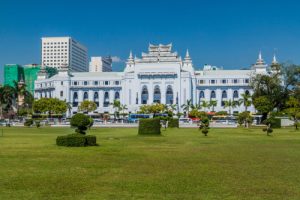
City Hall viewed from Maha B. Gardens
Bogyoke Aung San Museum – was the home of General Aug San for the 2 years prior to his assassination in 1947. However, his widow and 3 children, including Aung San Suu Kyi stayed on for another 6 years. The house is fairly sparsely furnished, there are a few old family photos and some personal possessions and not really much else. A modest tribute to the revered Aung San, but still well worth a visit! The house museum is located on Golden Valley Road, Bahan township, and can be a little tricky to find. Opening times are 9.30 am – 4.30 pm daily, except Mondays.
- Yangon Drugs Elimination Museum – is a somewhat peculiar must-see centre for those interested in the history of the country’s drug wars. Founded in 2001, the exhibitions cover war scenes and the political history as well as appropriate artwork about the horror of the battle against drugs.
- Yangon City Hall – completed in 1936, the iconic building is considered one of the best examples of Burmese architecture from the period throughout the entire country. Centrally located in the downtown area, it overlooks the atmospheric Maha Bandula Park, another must-see attraction.
Where to stay?
Unsurprisingly, Yangon offers by far the biggest range of accommodation in the country, where the number of rooms has been growing solidly, since 2010. Accordingly, there are great variations in accommodation costs, which are generally expensive in comparison to other Southeast Asian countries. During peak season, mid-November to January, demand for accommodation in Yangon can often outstrip supply, pushing up prices.
Guesthouses, which tend to be family-run, provide the cheapest accommodation option. And, while there can be a great difference in standards, some may have shared facilities, prices tend to be pretty similar. The cheapest hotels tend to be basic Chinese-style accommodation which offers few frills, and any you do get will come at extra cost. The mid to upper range of hotels offer a decent level of comfort but standards can vary and paying more doesn’t always guarantee a better room, so you need to do your homework to for best value. Luxury hotels will almost always be very comfortable and offer a full range of facilities, which will include a decent gym, a swimming pool and possibly exquisite gardens.
While prices can vary seasonally, expect to pay in the range of the following for 1 night for 2 people sharing:
Guesthouse: US$ 25
Basic Hotel: US$ 50 – 100
Mid-range/High-end Hotel: US$ 100 – 200
Luxury Hotel: US$ 250 – 500+

